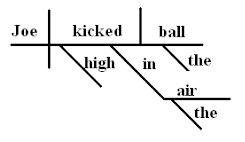The Reed-Kellogg system is a method for diagramming sentences that was commonly taught in grammar classrooms in the past. The system was introduced in the 1870s by Alonzo Reed and Brainerd Kellogg. Previous methods of diagramming focused solely on teaching proper word order to students. The Reed-Kellogg system offered an alternative, foregoing traditional word order in order to highlight the function of each word in a sentence. These grammarians believed that students would benefit from discovering the logical order of words in a sentence, allowing them to understand how to write effectively.
The Reed-Kellogg system’s primary purpose is to break a sentence down into easily identifiable parts. Because it is intended for students, the method is simple and uses a minimal amount of symbols or jargon. You do not have to know every single grammatical term in order to diagram a sentence using the Reed-Kellogg method, nor do you have to focus on retaining a sentence’s original word order. For those who have no background in grammar or who are learning English as a second language, the Reed-Kellogg diagram is a great way to jump into sentence diagramming. To start things off, here is a sample sentence that is simple in structure, as represented by Reed-Kellogg.
 In a Reed-Kellogg diagram, you always start by drawing a horizontal line. You then divide it with a short vertical line. The subject of the sentence is located on the left of the vertical dividing line. In this case, the subject is “the topic”. Any sentence modifiers, such as adjectives and articles, are placed on a diagonal line below the noun or verb it is modifying. As seen here, the indefinite article “the” is situated on a diagonal line below the noun “topic”.
In a Reed-Kellogg diagram, you always start by drawing a horizontal line. You then divide it with a short vertical line. The subject of the sentence is located on the left of the vertical dividing line. In this case, the subject is “the topic”. Any sentence modifiers, such as adjectives and articles, are placed on a diagonal line below the noun or verb it is modifying. As seen here, the indefinite article “the” is situated on a diagonal line below the noun “topic”.
The predicate of the sentence is located on the right side of the dividing line. Here, the predicate is the verb phrase “was sentence diagramming”. The verb “was” is situated in the middle of the diagram as a linking verb, which simply connects the subject “the topic” to the predicate “sentence diagramming”. This is reflected by a slanting line between “was” and the rest of the predicate. Since “sentence” is a modifier of the noun “diagramming”, it is placed on a diagonal line below what it modifies. We know “diagramming” is the noun and “sentence” is a modifier because we can ask “What type of diagramming?” and the answer is “Sentence diagramming.”
Now, let’s move onto a more complex Reed-Kellogg diagram. This one will show you how to diagram a sentence that contains a transitive action verb and a single direct object.
As you can see, this diagram is slightly different from the previous example. As the extremely simple subject of the sentence, “Joe” is on the left of the dividing vertical line. The predicate is where the meat of the sentence is. Since the verb is transitive, the line between the verb “kicked” and the direct object “ball” is straight rather than slanted. This indicates that Joe is performing an action with the ball. “High” and “in the air” are, respectively, an adverb and prepositional phrase that modify the verb “kicked” so they are given on diagonal lines below.
Although a Reed-Kellogg diagram has many positive aspects, it does have some drawbacks. Some sentences can be long and complex, especially if they’re taken from a piece of classical literature. Diagramming these sentences using this method can be intimidating and time-consuming. Unfortunately, the end result can be difficult to comprehend for anyone who is unfamiliar with the Reed-Kellogg system.
Additionally, while it is effective in illustrating general function within a sentence, it is not nuanced enough to show how each word in a sentence is connected to and dependent on the words around it. For example, look at the phrase “a beautiful woman”. A Reed-Kellogg diagram would list both “a” and “beautiful” as words that modify the noun “woman”. However, each of these words have different functions in the sentence. While “beautiful” modifies only the word “woman” as an adjective, “a” modifies both “beautiful” and “woman” as an indefinite article.
I hope that this post has given you a good idea of just what a Reed-Kellogg diagram is and how it is an effective (albeit traditional and therefore limited) tool for diagramming sentences. I would strongly advise that any aspiring author try diagramming at least one or two sentences in this style. I’m willing to bet that it will give you a greater understanding of grammar and improve your writing in the process.
Interested in more great content? Follow UNG Press on Facebook, Twitter, and Instagram and find our complete catalog on our homepage.


Leave a Reply